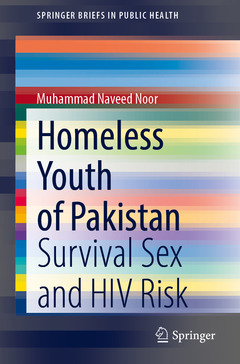Homeless Youth of Pakistan, 1st ed. 2021 Survival Sex and HIV Risk SpringerBriefs in Public Health Series
Auteur : Noor Muhammad Naveed

While homeless young people (HYP) are typically perceived as irresponsible and morally suspect individuals who lack essential social skills to navigate their lives, this book offers an alternative and more positive perspective. It demonstrates that HYP improvise with resources available on the streets to improve their social and financial status, although they experience significant social structural constraints.
This ground-breaking text provides an analysis of social processes that contribute to young people?s homelessness, their engagement in sex work, their establishment of intimate partnerships, and sexual practices which may increase their risk of HIV and other sexually transmitted infections (STIs). The book demonstrates how the ongoing social and financial instability and insecurity neutralises HYP?s knowledge of HIV/STIs, and how financial considerations, fear of violence by clients, and social obligations in intimate partnerships contribute to their sexual risk-taking. The author argues that the conventional approach of promoting health through raising awareness regarding HIV/STI prevention may continue to bring less than promising outcomes unless we focus on how structural and contextual conditions operate in the backdrop and produce conditions less conducive for young people.
Included in the coverage:
- factors that contribute to youth homelessness
- factors that shape sexual practice
- a Bourdieusian analysis of youth homelessness and sexual risk-taking
- a health promotion approach that can potentially reduce youth homelessness and their risk of HIV/STIs
Homeless Youth of Pakistan: Survival Sex and HIV Risk will attract undergraduate and postgraduate students, and researchers interested in exploring issues such as youth homelessness, sexual risk-taking, and HIV/STIs.
Chapter 1. Introduction.- Chapter 2. Understanding Youth Homelessness.- Chapter 3. Understanding Sexual Behaviour.- Chapter 4. The Theory of Capital and Social Practice.- Chapter 5. Methodological Approach to the Study.- Chapter 6. Capital-deficit and Youth Homelessness.- Chapter 7. The Street-field: A Capital-building Site.- Chapter 8. Sexual Risk-taking: Competing Priorities of Capital-building, Physical Safety, and Sexual Health.- Chapter 9. Key Messages and Implications for Health Promotion.
Muhammad Naveed Noor, MSc, MPhil, PhD is an Assistant Professor of Health Policy and System Research at the Aga Khan University, Karachi, Pakistan. Dr. Noor is trained in anthropology and social medicine. He received a PhD in social research in health from the University of New South Wales, Sydney, Australia. He has contributed to various programmatic studies into maternal health, sexual and reproductive health, and women’s dietary practices in the context of Pakistan. Dr. Noor is currently part of an international team that investigates conflict of interest in medical profession and practice and how this contributes to overprescribing of antibiotics in Pakistan.
Date de parution : 08-2021
Ouvrage de 103 p.
15.5x23.5 cm
Thèmes de Homeless Youth of Pakistan :
Mots-clés :
homeless young people; street-life; survival sex; HIV; sexual risk-taking; vulnerability; intimate relationships; sexually transmitted infections (STIs); health promotion; adolescent sexual health; youth homelessness; social capital; safer sex vs; risky sex; Bourdieusian theory; Pakistan



